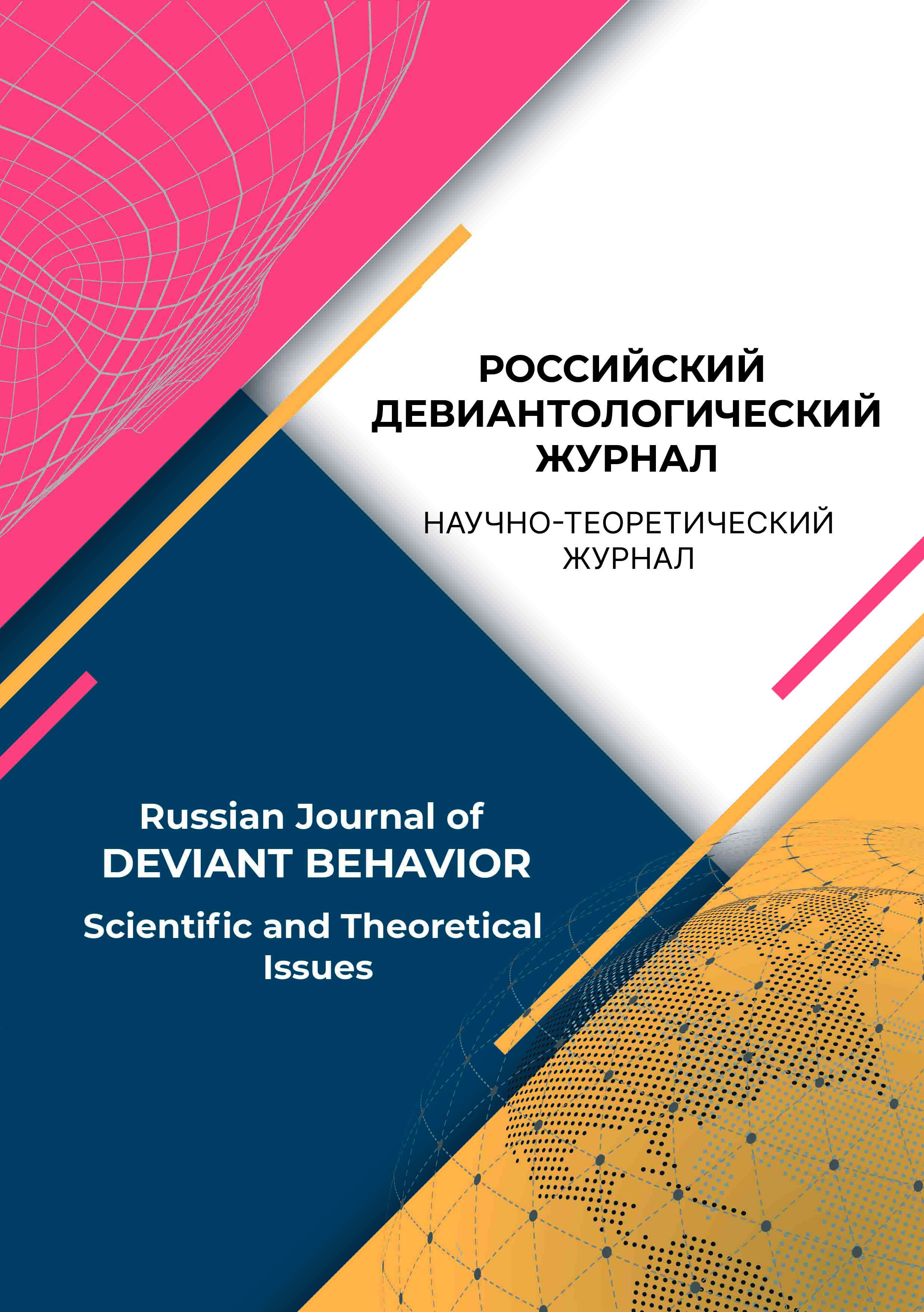from 01.01.2014 until now
St. Petersburg, St. Petersburg, Russian Federation
Introduction. Aggressiveness is one of the forms of manifestation of the personality deviations and is differentiated by the degree of intensity from its normal indicators to extreme ones. In the activities of police officers, aggressiveness acts as a defense mechanism, which often exceeds the limits of moderately protective reactions and reaches the level of extreme aggression, manifested as an inadequate response to the exposure of the environmental stimuli. Theoretical analysis of the phenomena of aggressiveness and hostility, as well as the peculiarities of their manifestation in the professional activities of police officers shows the propensity of employees to aggressive and hostile forms of behavior, characterized by stability and stereotypes, determined by both the emotions of fear and formed personality deformities, pathological properties of character. The need for self-control of emotional reactions and lack of competence in assessing the emotional states of others increases the risks of aggressiveness and deviant behavior of police officers and forms a type of destructive personality. For the sphere of professional activity this is a significant obstacle in ensuring its effectiveness and reliability. Prevention of aggressiveness and hostility requires the development and implementation of technology that ensures the development of negative affects regulation skills, emotional states and behavior. The purpose of the study was to identify the degree of intensity of various indicators of aggressiveness and hostility of police officers, as well as to analyze their changes due to the application of the technology development abilities of emotional-volitional self-regulation. Methodology, methods and techniques. A complex of empirical and mathematical methods was used in the analysis of changes in the aggression indicators. Empirical data were obtained with the following techniques: the scale of neuropsychic adaptation (J.N. Gurvich), the method «Types of aggressiveness» (L.G. Pochebut), the Cook-Medley Hostility Scale. Data processing was performed using a specialized software package IBM SPSS Statistics 23 and Microsoft Excel. The research used a comparative analysis of empirical data. A group of employees (n=82) with signs of neuropsychic maladaptation of a nonpathological nature was separated from the total sample of subjects (n=253) and divided into an experimental (n=41) and a control group (n=41). In the experimental group, classes were organized for the development of abilities to emotional-volitional self-regulation (forming experiment). Results and interpretation. A comparative analysis of the values of aggressiveness and hostility of police officers before and after the experiment showed reliable differences for 3 indicators out of 9 (33.33%): self-aggression, total aggressiveness index, and hostility. In the values of the control and experimental groups during the realization of the ascertaining experiment no reliable differences were revealed, after the experiment statistically significant differences in the indicators were found: verbal aggression, emotional aggression, self-aggression, total aggressiveness index, cynicism, aggressiveness, hostility. Scientific novelty of the study lies in identifying the indicators of aggression and hostility of police officers experiencing states of neuropsychic maladaptation, in clarifying the role of abilities to emotional and volitional self-regulation in the prevention of aggression and hostility, in determining the parameters of changes in the intensity of aggressive and hostile manifestations in the experiment. Practical Significance. The change in the indicators of aggressiveness and hostility, identified as a result of the forming experiment, indicates the effectiveness of the technology development abilities to emotional and volitional self-regulation and on this basis allows to develop author programs to manage negative emotions and implement the prevention of deviant behavior of police officers.
aggressiveness, hostility, cynicism, emotional-volitional self-regulation, police officer
1. Bel’tyukova, A. V. (2019). Ponyatie obidchivosti: priroda vozniknoveniya, osobennosti proyavleniya. Vestnik Udmurtskogo universiteta. Seriya «Filosofiya. Psihologiya. Pedagogika», 29 (3), 262-267.
2. Beron, R., Richardson, D. (2001). Agressiya. Saint Petersburg: Piter.
3. Goncharova, N. A. Popinako, E. A. (2020). Analiz dominiruyushchih sostoyanij lichnosti v prognoze adaptacii k professional’noj deyatel’nosti sotrudnikov organov vnutrennih del. Prikladnaya yuridicheskaya psihologiya, 2(51), 41-50. https://doi.org/10.33463/2072-8336.2020.2(51).041-050
4. Goncharova, N. A. (2021). Vliyanie izmenenij metodov upravleniya personalom na proyavleniya agressivnosti i konfliktnosti sotrudnikov. Modern Science, 1-1, 372-375.
5. Il’in, E. P. (2001). Emocii i chuvstva. Saint Petersburg: Piter.
6. Kalashnikova, M. M. (2009). Razvitie stressoustojchivosti sotrudnikov operativnogo sostava MVD: avtoref. dis. … kand. psihol. nauk. Kazan’.
7. Kruk, V. M., Fedotov, A. Yu. (2021). Psihologicheskie osobennosti ovladeniya specialistom tekhnologiej samoregulyacii v ramkah obespecheniya professional’noj nadezhnosti. Psihologiya obucheniya, 2, 47-54.
8. Orlov, Yu. M. (2004). Obida. Vina. Moskow: Slajding.
9. Rean, A. A. (2013). Psihologiya lichnosti. Saint Petersburg: Piter.
10. Suvorova, O. V., Sorokoumova, S. N., Frundina, M. N. (2017). Lichnostnye determinanty empatii i agressii sovremennyh podrostkov. Problemy sovremennogo pedagogicheskogo obrazovaniya, 56-3, 337-346.
11. Allen, J. J., & Anderson, C. A. (2017). Aggression and violence: Definitions and distinctions. In P. Sturmey (Ed.), The wiley handbook of violence and aggression (pp. 4-16). UK: John Wiley & Sons.
12. Anderson, C. A., & Bushman, B. J. (2002). Human aggression. Annual Review of Psychology, 53, 27-51. https://doi.org/10.1146/annurev.psych.53.100901.135231
13. Anderson, C. A., Deuser, W. E., & DeNeve, K. M. (1995). Hot temperatures, hostile affect, hostile cognition, and arousal: Tests of a general model of affective aggression. Personality and Social Psychology Bulletin, 21, 434-448.
14. Bakker, A. B., & Heuven, E. (2006). Emotional dissonance, burnout, and in-role performance among nurses and police officers. International Journal of Stress Management, 13(4), 423-440. https://doi.org/10.1037/1072-5245.13.4.423
15. Berking, M., Meier, C., & Wupperman, P. (2010). Enhancing Emotion-Regulation Skills in Police Officers: Results of a Pilot Controlled Study. Behavior therapy, 41 (3). 329-339. https://doi.org/10.1016/j.beth.2009.08.001
16. Berkowitz, L. (1993). Aggression: Its causes, consequences, and control. New York, NY: McGraw-Hill.
17. Berkowitz, L. (1998). Affective aggression: The role of stress, pain, and negative affect. In R. G. Geen & E. Donnerstein (Eds.), Human aggression: Theories, research, and implications for social policy (pp. 49-72). San Diego, CA: Academic Press.
18. Bryant, J., & Zillmann, D. (1979). Effect of intensification of annoyance through unrelated residual excitation on substantially delayed hostile behavior. Journal of Experimental Social Psychology, 15, 470-480.
19. Buss, A. H., & Durkee, A. (1957). An inventory for assessing different kinds of hostility. Journal of Consulting Psychology, 21 (4), 343-349. https://doi.org/10.1037/h0046900
20. Buss, A. H., & Perry, M. (1992). The aggression questionnaire. Journal of Personality and Social Psychology, 63, 452-459.
21. Geen, R. G. (2001). Human aggression (2nd ed.). Buckingham, UK: Open University Press.
22. Griffin, S., & Bernard, Th. (2003). Angry Aggression Among Police Officers. Police Quarterly, 6. 3-21. https://doi.org/10.1177/1098611102250365
23. Hochschild, A. R. (2003). The managed heart: Commercialization of human feeling (20th ed.). Berkeley, CA:University of California Press.
24. Huesmann, L. R., Guerra, N. G., Miller, L. S., & Zelli, A. (1992). The Role of Social Norms in the Development of Aggressive Behavior. In: A. Fraczek, H. Zumkley (Eds.), Socialization and Aggression. Recent Research in Psychology. Springer, Berlin, Heidelberg. https://doi.org/10.1007/978-3-642-84653-3_9
25. Krahe, B. (2013). The social psychology of aggression (2nd ed.). New York, NY: Psychology Press.
26. Lindsay, J. J., & Anderson, C. A. (2000). From antecedent conditions to violent actions: A general affective aggression model. Personality and Social Psychology Bulletin, 26, 533-547.
27. O’Neill, J. L., & Cushing, M. A. (1991). The impact of shift work on police officers. Washington, D.C.: Police Executive Research Forum.
28. Pennebaker, J. W., Susman, J. R. (1988). Disclosure of traumas and psychosomatic. Social Science & Medicine, 26(3), 327-332.
29. Pytel-Pandey, D. (2021). Agresja językowa wyrażona dyrektywnymi aktami mowy (żądania). Slavica Wratislaviensia, 174, 151-161. https://doi.org/10.19195/0137-1150.174.12
30. Richardson, D. R. (1994). Human aggression. New York; London: Plenum press, Cop. Perspectives in social psychology.
31. Roberton, T., Daffern, M., & Bucks, R. (2012). Emotion regulation and aggression. Aggression and Violent Behavior, 17, 72-82. https://doi.org/10.1016/j.avb.2011.09.006
32. Romosiou, V., Brouzos, A., & Vassilopoulos, S. P. (2018). An integrative group intervention for the enhancement of emotional intelligence, empathy, resilience and stress management among police officers. Police Practice and Research, 20 (5), 460-478. https://doi.org/10.1080/15614263.2018.1537847
33. Santos, D., Briñol, P., Petty, R. E., Gandarillas, B., & Mateos, R. (2019). Trait aggressiveness predicting aggressive behavior: The moderating role of meta-cognitive certainty. Aggressive Behavior, 45 (3), 255-264. https://doi.org/10.1002/ab.21815














